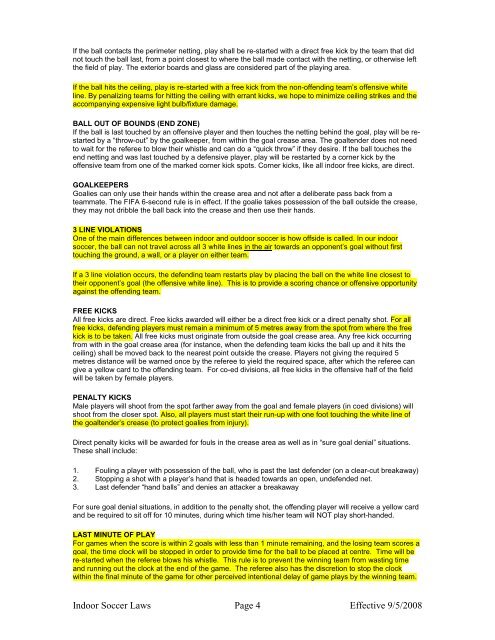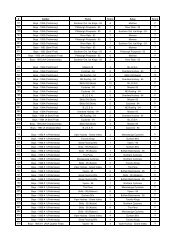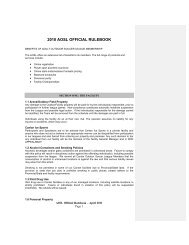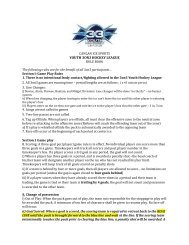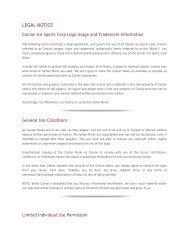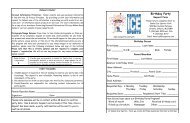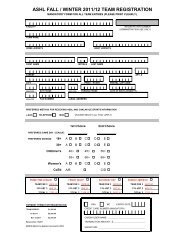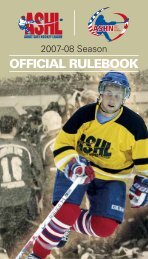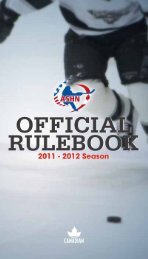Canlan Indoor Soccer Center Burnaby 8 Rinks ... - Canlan Ice Sports
Canlan Indoor Soccer Center Burnaby 8 Rinks ... - Canlan Ice Sports
Canlan Indoor Soccer Center Burnaby 8 Rinks ... - Canlan Ice Sports
You also want an ePaper? Increase the reach of your titles
YUMPU automatically turns print PDFs into web optimized ePapers that Google loves.
If the ball contacts the perimeter netting, play shall be re-started with a direct free kick by the team that did<br />
not touch the ball last, from a point closest to where the ball made contact with the netting, or otherwise left<br />
the field of play. The exterior boards and glass are considered part of the playing area.<br />
If the ball hits the ceiling, play is re-started with a free kick from the non-offending team’s offensive white<br />
line. By penalizing teams for hitting the ceiling with errant kicks, we hope to minimize ceiling strikes and the<br />
accompanying expensive light bulb/fixture damage.<br />
BALL OUT OF BOUNDS (END ZONE)<br />
If the ball is last touched by an offensive player and then touches the netting behind the goal, play will be restarted<br />
by a “throw-out” by the goalkeeper, from within the goal crease area. The goaltender does not need<br />
to wait for the referee to blow their whistle and can do a “quick throw” if they desire. If the ball touches the<br />
end netting and was last touched by a defensive player, play will be restarted by a corner kick by the<br />
offensive team from one of the marked corner kick spots. Corner kicks, like all indoor free kicks, are direct.<br />
GOALKEEPERS<br />
Goalies can only use their hands within the crease area and not after a deliberate pass back from a<br />
teammate. The FIFA 6-second rule is in effect. If the goalie takes possession of the ball outside the crease,<br />
they may not dribble the ball back into the crease and then use their hands.<br />
3 LINE VIOLATIONS<br />
One of the main differences between indoor and outdoor soccer is how offside is called. In our indoor<br />
soccer, the ball can not travel across all 3 white lines in the air towards an opponent’s goal without first<br />
touching the ground, a wall, or a player on either team.<br />
If a 3 line violation occurs, the defending team restarts play by placing the ball on the white line closest to<br />
their opponent’s goal (the offensive white line). This is to provide a scoring chance or offensive opportunity<br />
against the offending team.<br />
FREE KICKS<br />
All free kicks are direct. Free kicks awarded will either be a direct free kick or a direct penalty shot. For all<br />
free kicks, defending players must remain a minimum of 5 metres away from the spot from where the free<br />
kick is to be taken. All free kicks must originate from outside the goal crease area. Any free kick occurring<br />
from with in the goal crease area (for instance, when the defending team kicks the ball up and it hits the<br />
ceiling) shall be moved back to the nearest point outside the crease. Players not giving the required 5<br />
metres distance will be warned once by the referee to yield the required space, after which the referee can<br />
give a yellow card to the offending team. For co-ed divisions, all free kicks in the offensive half of the field<br />
will be taken by female players.<br />
PENALTY KICKS<br />
Male players will shoot from the spot farther away from the goal and female players (in coed divisions) will<br />
shoot from the closer spot. Also, all players must start their run-up with one foot touching the white line of<br />
the goaltender’s crease (to protect goalies from injury).<br />
Direct penalty kicks will be awarded for fouls in the crease area as well as in “sure goal denial” situations.<br />
These shall include:<br />
1. Fouling a player with possession of the ball, who is past the last defender (on a clear-cut breakaway)<br />
2. Stopping a shot with a player’s hand that is headed towards an open, undefended net.<br />
3. Last defender “hand balls” and denies an attacker a breakaway<br />
For sure goal denial situations, in addition to the penalty shot, the offending player will receive a yellow card<br />
and be required to sit off for 10 minutes, during which time his/her team will NOT play short-handed.<br />
LAST MINUTE OF PLAY<br />
For games when the score is within 2 goals with less than 1 minute remaining, and the losing team scores a<br />
goal, the time clock will be stopped in order to provide time for the ball to be placed at centre. Time will be<br />
re-started when the referee blows his whistle. This rule is to prevent the winning team from wasting time<br />
and running out the clock at the end of the game. The referee also has the discretion to stop the clock<br />
within the final minute of the game for other perceived intentional delay of game plays by the winning team.<br />
<strong>Indoor</strong> <strong>Soccer</strong> Laws Page 4 Effective 9/5/2008


